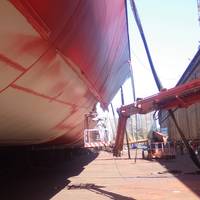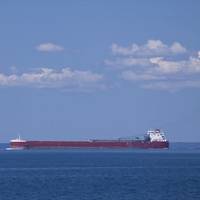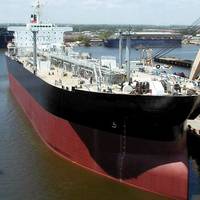DFDS RoRo Gets a New Coat

Environmentally safe underwater ship hull coating helps DFDS fulfill its ecological goals.Last July the underwater hull of the roro vessel Magnolia Seaways was coated with Ecospeed in Gdansk, Poland. This non-toxic and easy washable coating system will keep the hull smooth for the service life of the vessel with minimal repair and no replacement. At the same time the rudder of the ship was treated with an Ecoshield coating which was designed specifically to protect underwater…
Study: Nonnative Species Carried in Lakers' Ballast Water

A recent study on nonindigenous species of plankton in ballast discharges from U.S. and Canadian lakers to western Lake Superior documented five species of nonindigenous zooplankton not yet established in western Lake Superior, including Hemimysis anomala (“bloody red shrimp”), in ballast water discharged there. It also detected, in uptake water, a species of zooplankton (Paraleptastacus wilsoni) that had not previously been recorded in the Great Lakes.Some of the species, including this one, live in harbor sediment and may have escaped routine surveillance to date.
California Clarifies BWMS Position
Installation or use of an USCG accepted Alternative Management Systems (AMS) does not waive a vessel's requirement to meet the California Code of Regulations ballast discharge performance standards. In accordance with the California Public Resource Code and California Code of Regulations, vessels may manage ballast water using an alternative, environmentally sound method approved by the California State Lands Commission or the USCG as being at least as effective as ballast water exchange, using mid-ocean waters, in eliminating nonindigenous species. As any USCG accepted AMS must demonstrate efficacy at least as effective as mid-ocean exchange…
Ballast Water Treatment – USCG Amending Regulations
USCG to amend regulations on BWT systems, allowable concentration living organisms The Coast Guard is amending its regulations on ballast water management by establishing a standard for the allowable concentration of living organisms in ships' ballast water discharged in waters of the United States. The Coast Guard is also amending its regulations for engineering equipment by establishing an approval process for ballast water management systems. These new regulations will aid in controlling the introduction and spread of nonindigenous species from ships' ballast water in waters of the United States.
U.S. BWT Standard is Published
Coast Guard issues standard for living organisms in ships' discharged ballast water. The U.S. Coast Guard announced Friday the final rule for standards for living organisms in ships' ballast water discharged into waters of the United States is scheduled for publication March 23 in the Federal Register. A public inspection copy of the final rule is available online. The Coast Guard is amending its regulations on ballast water management by establishing a standard for the allowable concentration of living organisms in ballast water discharged from ships in waters of the United States. The Coast Guard is also amending its regulations for engineering equipment by establishing an approval process for ballast water management systems.
Corps Reschedules Ann Arbor Meeting on GLMRIS
The public scoping meeting scheduled for Thursday, Feb. 3, 2011 by the U.S. Army Corps of Engineers, has been rescheduled for Tuesday, March 8 for the same time and at the same location: from 2:00 p.m. to 8:00 p.m. at the Ann Arbor Marriott Ypsilanti at Eagle Crest, located at 1275 S. Huron St. The purpose of the meeting is to gather input on the Great Lakes and Mississippi River Interbasin Study, GLMRIS. The public is invited to attend to provide comments on GLMRIS. Identical presentations about the study will be given at 2:15 p.m. and 5:45 p.m., each followed by the comment period. The purpose of GLMRIS is to evaluate a range of options and technologies to prevent the transfer of aquatic nuisance species, ANS, between the Great Lakes and Mississippi River through aquatic pathways.
BALPURE System Authorized in California

The S/R American Progress, a double-hull U.S. flag tank ship, operated by SeaRiver Maritime, Inc., and fitted with the BALPURE ballast water management system from Severn Trent De Nora, is authorized to discharge treated ballast water into the water of California. Authorization was granted by the California State Lands Commission in accordance with California Public Resources Code Section 71204.3(d), which authorizes vessels to manage their ballast water using alternative, environmentally…
Standards for Ballast Water Discharge
The US Coast Guard proposes to amend its regulations on ballast water management by establishing standards for the allowable concentration of living organisms in ships’ ballast water discharged in US waters. It also proposes to amend its regulations for approving engineering equipment by establishing an approval process for ballast water management systems. These proposed regulations are intended to aid in controlling the introduction and spread of nonindigenous species from ships discharging ballast water in US waters. The ballast water discharge standards would be used to approve ballast water management systems that are at least as effective as ballast water exchange in preventing or reducing the introduction of nonindigenous species via discharged ballast water.
Guilty Plea, Crimes Related to Pollution
A Greek citizen, Panagiotis Lekkas, the captain of the bulk cargo ship the M/V Theotokos, pleaded guilty to four felony counts in federal court in New Orleans for violating anti-pollution laws, ship safety laws and obstructing a U.S. Coast Guard investigation, the Justice Department announced. Additionally, a Philippine citizen, Charles P. Posas, the second highest officer onboard the M/V Theotokos, pleaded guilty to two felony counts of lying to the Coast Guard and violating recordkeeping laws aimed at reducing the risk of marine invasive species. Posas is the first individual ever charged under the anti-invasive species law, a law designed to mitigate the introduction of marine invasive species into waters of the United States.
Legal: Careful ... Your TBT May Be Showing
If you thought hull anti-fouling systems were boring (think Teredo worm), then you haven't been paying attention to the controversy surrounding use of organotin compounds on the underwater hulls of ships. Fouling has been a problem for ships since time immemorial. The Teredo worm (scientific name: Teredo navalis) was recognized as one of most threatening of marine fouling organisms because it bored into the hulls of wooden ships, potentially damaging watertight integrity. Other fouling organisms adversely impacted the speed of ships. Naval and merchant vessels responded by regularly scrapping the hulls (generally by careening the ship) and by placing sheathing on the underwater hull.
USCG Seeks Ballast Water Treatment Testing Participants
The U.S. Coast Guard announced the beginning of a program aimed at facilitating the installation of experimental shipboard ballast water treatment systems. Foreign and domestic vessel owners that participate in the program may be granted equivalencies to U.S. ballast water regulations for participating vessels. The Shipboard Technology Evaluation Program (STEP) is one of several Coast Guard initiatives aimed at reducing the introduction of nonindigenous species (NIS) to U.S. waters through ballast water. The impacts of NIS on our environment, food supply, economy, health and overall biodiversity of our waterways are significant and increasing. "This is one of the many things we are doing to protect our waters," said Capt.
Not in Compliance with Ballast Rules? You Will Pay
The U.S. Coast Guard published regulations establishing penalties for ships headed to the U.S. that fail to submit a ballast water management reporting form, as well as vessels bound for the Great Lakes or portions of the Hudson River that violate mandatory ballast water management requirements. These regulations also increase the number of vessels subject to the reporting and recordkeeping provisions and expand the reporting and recordkeeping requirements on ships, increasing the Coast Guard’s ability to prevent the introduction of nonindigenous species as required by the Nonindigenous Aquatic Nuisance Prevention and Control Act and the National Invasive Species Act.
Effective Means Of Combating Invasive Aquatic Species Urged
Witnesses representing the shipping industry, ports, and an environmental organization met on May 15 to urge the development of mandatory federal ballast water management regulations and alternative management options to more effectively address the problem of aquatic invasive species in the United States. The joint hearing of the U.S. House Water Resources and Environment Subcommittee and the Coast Guard and Maritime Transportation Subcommittee focused on the implementation of the National Invasive Species Act of 1996 (NISA), which addresses aquatic invasive species and required the Transportation Secretary to issue voluntary guidelines to prevent the introduction of invasive species by vessels equipped with ballast water tanks.
U.S. Ports Endorse Ballast Water Legislation
In response to the growing trend of state laws regulating ballast water discharges from ships, U.S. ports plan to develop a legislative proposal that would: 1) establish a strong Federal ballast water management program; and, 2) preempt state legislation in this area. During the Monday, October 16, meeting of AAPA's U.S. Legislative Policy Council (USLPC) representing the Association's 84 U.S. port members, Chairman of the Board J. Robert Bray, Executive Director of the Virginia Port Authority, led the discussion of concepts for legislation in the area of ballast water and introduction of nonindigenous species. The USLPC voted unanimously to adopt the position which reflects Association members' growing concern over the development of new regulations in this area.
Shipboard Technology Evaluation Program
The U.S. Coast Guard issued a Notice announcing availability of the Programmatic Environmental Assessment (PEA) regarding the Shipboard Technology Evaluation Program (STEP). The purpose of STEP is to facilitate development of effective ballast water treatment technologies to protect coastal and inland waters against unintentional introduction of nonindigenous species via ballast water discharges. 69 Fed. Reg. 71068 (HK Law).
USCG to Hold Meeting on Great Lakes Species Invasion
The Coast Guard will hold a public meeting on May 9 in Cleveland seeking public assistance in further preventing aquatic nonindigenous species from entering the Great Lakes from the ballast water discharged from oceangoing vessels. Specifically, the Coast Guard is exploring ways to manage the ballast water on vessels entering the Great Lakes that have so little water in their ballast tanks, they cannot pump it out and thus declare they are “No Ballast Onboard” vessels, or NOBOBs. “Protecting the Great Lakes from invasive species is an important issue for the Coast Guard. I expect that working with the public will greatly assist us in developing effective and practicable management strategies for NOBOBs,” said Coast Guard Rear Adm.
Interagency Development of Ballast Water Discharge Standards
The Coast Guard will work with the Department of Agriculture's Animal and Plant Health Inspection Service (APHIS) in the continued development of new federal regulations on ballast water discharge standards. APHIS joins a federal partnership that also includes the Environmental Protection Agency, the National Oceanic and Atmospheric Administration, and the U.S. Fish and Wildlife Service, all of which are contributing technical expertise to the Coast Guard-led federal rulemaking. The rulemaking is intended to spur vessels to use a variety of ballast water treatment technologies to prevent the introduction and spread of aquatic nonindigenous species, such as viral hemorrhagic septicemia.
Coast Guard Proposes National Ballast Water Management Program
The U.S. of nonindigenous species in U.S. waters through ballast water discharges. economic impacts. lifestyles. vessels equipped with ballast water tanks that operate in U.S. enter U.S. waters after operating beyond the exclusive economic zone (EEZ). Specifically, vessels entering U.S. · Prior to discharging ballast water in U.S. · Prior to the vessel entering U.S. approved by the U.S. · Discharge ballast water to an approved reception facility.
Great Lakes: Ballast Water Management
The U.S. Coast Guard issued best management practices for vessels entering the Great Lakes or the Hudson River north of the George Washington Bridge and declaring no ballast onboard (NOBOB). These practices are intended to minimize the likelihood of inadvertent introduction of aquatic nonindigenous species. The practices include, among other things, conducting either mid-ocean ballast water exchange or mid-ocean saltwater flushing. The draft environmental assessment should be widely available shortly. Comments should be submitted by September 30. 70 Fed. Reg. 51831 (HK Law)






